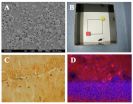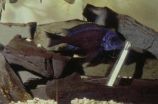In a new study, Hansa Done, PhD candidate, and Rolf Halden, PhD, researchers at Arizona State University's Biodesign Institute, examine antibiotic use in the rapidly expanding world of global aquaculture.
Done and Halden measured the presence of antibiotics in shrimp, salmon, catfish, trout, tilapia and swai, originating from 11 countries. Data showed traces of 5 of the 47 antibiotics evaluated.
The research findings and a discussion of their implications appear in the current issue of the Journal of Hazardous Materials.
Charting resistance
The menace of germs bearing resistance to our best medical defenses is reaching crisis proportions. Each year, resistant microbes sicken some 2 million people in the U.S. alone and kill about 23, 000, according to the Infectious Diseases Society of America.
On September 18, President Obama proposed the first governmental steps to address the problem, establishing a task force to be co-chaired by the secretaries of Health and Human Services, the Department of Defense, and the Department of Agriculture.
The new initiative to reign in antibiotic overuse has been welcomed in the medical community, though many believe that much more needs to be done to safeguard society. The chief complaint is that the proposed measures largely ignore the largest consumers of antibiotics—animals farmed for human consumption, including fish.
"The threat of living in a post-antibiotic era cannot be avoided without revising current practices in the use of antibiotics in animal husbandry, including in aquaculture," says Halden.
Halden, who directs the Biodesign Institute's Center for Environmental Security, is a leading authority on the human and environmental impact of chemicals, (particularly their fate once their useful life has ended). In previous research, he has explored the intricate pathways from production to postconsumption fate of antimicrobials and the risks posed.
The new study examines the persistence of antibiotics in seafood raised by modern aquaculture. The research area is largely unexplored, as the primary focus of studies of antibiotics has been on drugs used in human medicine. The current research is the first to evaluate previously unmonitored antibiotics; it represents the largest reconnaissance conducted to date on antibiotics present in seafood.
Farming lifestyle
Aquaculture has undergone rapid growth to meet the burgeoning global demand, nearly tripling over the past 20 years to an estimated 83 million metric tons in 2013. The large increase has led to widespread antibiotic use, applied both to prevent and treat pathogens known to infect fish. The broad effects on health and the environment associated with these practices remain speculative.
Several natural mechanisms exist to help pathogenic microbes evade immune responses or develop drug resistance over time. The overuse of antibiotics, whether for human ingestion in hospitals or for agricultural or aquacultural use, can seriously exacerbate this problem, enriching microbes that bear particular genetic mutations, rendering them antibiotic resistant. In a biological arms race, antibiotics applied to combat disease run the risk of producing multi-drug resistant organisms that are increasingly difficult to kill.
In the new study, 27 seafood samples were examined for the presence of antibiotics. The samples represent five of the top 10 most consumed seafood varieties in the U.S.: shrimp, tilapia, catfish, swai, and Atlantic salmon. The National Oceanic and Atmospheric Administration (NOAA) acquired the samples from stores in Arizona and California.
Five antibiotics were present in detectable amounts: oxytetracycline in wild shrimp, farmed tilapia, farmed salmon and farmed trout; 4-epioxytetracycline in farmed salmon, sulfadimethoxine in farmed shrimp, ormetoprim in farmed salmon, and virginiamycin in farmed salmon that had been marketed as antibiotic-free.
Oxytetracycline, the most commonly used antibiotic in aquaculture, was the most prevalent in the study samples. Surprisingly, the study also detected this antibiotic in wild-caught shrimp imported from Mexico, which the authors suggest may be due to mislabeling, coastal pollution from sewage contamination, or cross-contamination during handling and processing.
On the bright side, all seafood analyzed was found to be in compliance with U.S. FDA regulations; however, the authors note that sub-regulatory antibiotic levels can promote resistance development, according to their extensive meta-analysis of existing literature. (Publications linking aquaculture with antibiotic resistance have increased more than 8-fold from 1991-2013.)
Antibiotics also have the potential to affect the animals themselves, producing alterations in how genes are turned on or off and physiological anomalies. (The latter may include malformations of the spine in trout exposed to the antibiotic oxytetracycline, though more work will be needed to clarify this association.)
Proper monitoring of antibiotic residues in seafood is particularly critical, due to the fact that many antibiotics used in aquaculture are also used in human medicine, for example amoxicillin and ampicillin—common therapeutics for the treatment of bacterial infections, including pneumonia and gastroenteritis.
The future of fish
The use of antibiotics in aquaculture can produce a variety of unintended consequences in addition to antibiotic resistance, including antibiotic dissemination into the surrounding environment, residual concentrations remaining in seafood, and high antibiotic exposure for personnel working in aquaculture facilities.
Changes in aquaculture are needed to ensure the practice can be carried out on a large scale in a sustainable manner. Currently, massive aquaculture operations threaten the health of seas, due to large volumes of fish waste emitted, containing excess nutrients, large amounts of pathogens, and drug resistance genes.
Additionally, many types of farmed fish rely on fishmeal produced from by-catch caught in fishing nets. Several pounds of fishmeal are often required to raise a single pound of farmed fish, thereby contributing to the overfishing of the seas and depletion of ocean diversity.
The current study offers a warning that antibiotics present at levels well below regulatory limits can still promote the development of drug-resistant microorganisms. The dramatic increase in resistant and multi-drug resistant bacterial strains documented over the past three decades indicates that much more thorough monitoring of seafood supplies is needed and a better scientific understanding of the nexus of global aquaculture, antibiotic use, drug resistance emergence, and regulatory measures.
INFORMATION: END







